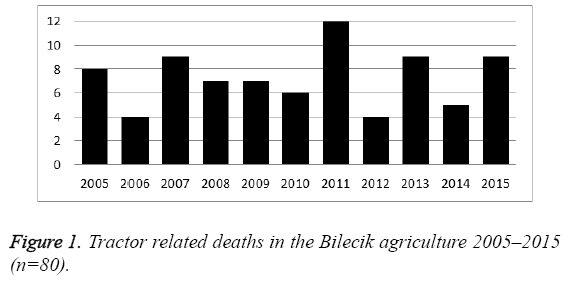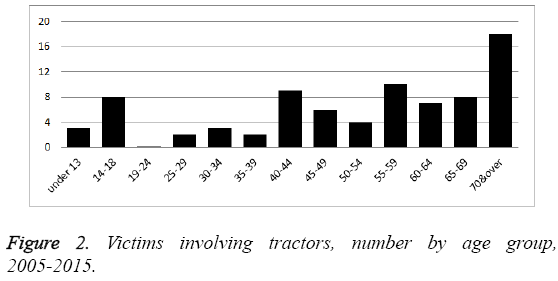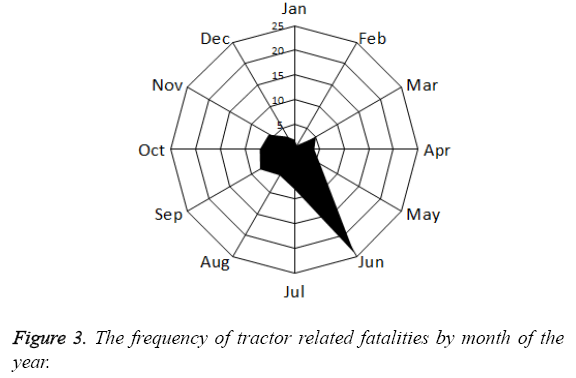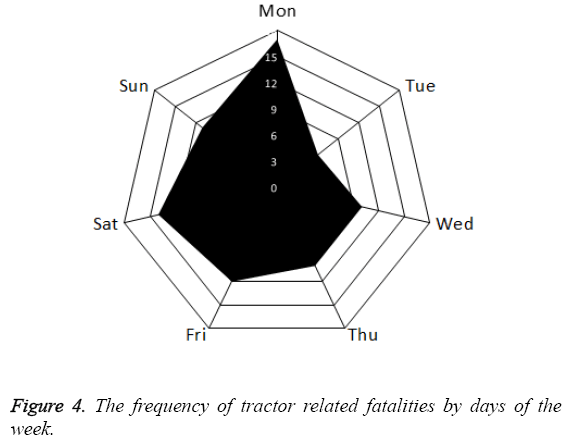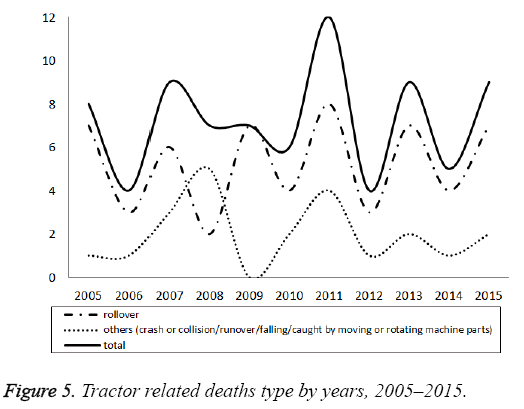Research Article - Biomedical Research (2017) Volume 28, Issue 2
Fatal tractor injuries between 2005 and 2015 in Bilecik, Turkey
E. Selcen Darçın1*, Murat Darçın21Faculty of Agriculture and Natural Sciences, Department of Field Crops, Bilecik Şeyh Edebali University, Bilecik, Turkey
2Ministry of Interior Affairs, Ankara, Turkey
- *Corresponding Author:
- E. Selcen Darçın
Department of Field Crops, Bilecik Seyh Edebali University
Hurriyet Mah Villa Sk 4/1, Merkez Bilecik
Bilecik, Turkey
Accepted date: May 12, 2016
Abstract
Tractors have been identified as being associated with more fatalities than any other piece of machinery in agriculture; however, very little information is available about the type and nature of tractor related injuries in Turkey. This study was performed to describe the factors associated with fatal tractor injuries between 2005 and 2015 in Bilecik, Turkey. During the study period, 80 tractor fatalities were investigated. Deaths occurred significantly more frequent during the rollover (72.5%), followed by crash or collision with motor vehicle (11.25%). Almost a quarter of all farm deaths involve farmers over 70 years of age. The highest numbers of fatalities occurred in June on Mondays and during the period from 11 a.m. to 3 p.m. Despite considerable efforts agriculture continues to be a problematic sector to ensure desirable and required levels of safety standards. National awareness of existing risks and occupational safety and health in agriculture should be raised.
Keywords
Accident, Agriculture, Fatality, Occupational health and safety, Tractor.
Introduction
More than a third of the world’s labour force is employed in agriculture. Available evidence clearly shows that agriculture is in fact one of the most hazardous and deadliest sectors [1]. Because of nature of the work, the fatal accident rate in agriculture is more than the average for all other industries. A unique combination of cultural, socio-economic, and environmental factors influence living conditions of farmers and agricultural workers. Furthermore, social and economic pressures can cause serious health problems [1].
Unlike the industrial work, agriculture involves people of all ages and different physical capabilities. Elderly farmers and agricultural workers are vulnerable to accidents due to declines in visual acuity, or sharpness of vision, age-related hearing loss, and decreases in sense of touch. They do not retire at a certain age like some other occupations, but rather they continue to use machines and tractors in heavy physical condition. Because of the usage habits as a transportation vehicle in daily life and socio-economic reasons, the demand for tractors in Turkey is quite high. Tractors are the most vital, but deadliest machine to increase production and effectiveness in agriculture. Among all agricultural machines, tractors have been identified as being associated with more fatalities than any other piece of machinery in agriculture [2,3].
Increased use of tractor along with other agricultural inputs has enhanced the production and productivity of Turkish farms. Simultaneously, it has also increased occupational health hazards on the farms. In Turkey, the number of tractor per area (ha) is 56.25 (tractors/1000ha). According to the statistical data [4], Turkish Tractor Park is composed of 1.6 million tractors. Average age of the tractor park is 24 years. About 48% of the park consists of tractors older than 25 years, whose average age is 37.5 years. Continue to use older model tractors that have completed their rational life is a major occupational health and safety risk.
Tractors have been recognized for years as the leading cause of agricultural fatalities in Turkey; however, very little research for the purpose of developing prevention and intervention strategies has been conducted. In Turkey, there are no published statistical data concerning tractor related fatalities in agriculture sector. Very little information is available about the type and nature of tractor related injuries on Turkish farms. There have been also no detailed accident report based studies of tractor-related fatalities in Turkey. It is proposed that this study will fill that gap.
This study was performed to describe the factors associated with fatal tractor injuries between 2005 and 2015 in Bilecik, Turkey. The data sources were the work accident reports, accident investigation reports, traffic accident reports, and dialogue with bystanders. No recent study has specifically analysed the factors involved in tractor related deaths that have occurred in Bilecik. To reduce the number of fatalities it is necessary to identify the factors involved. The purpose of this study was to recognize specific factors involved with tractor related fatalities in Bilecik, Turkey, during 11 year period and to recommend strategies for reducing these deaths.
Materials and Methods
This study of all tractor-related fatalities in Bilecik for the period 2005 to 2015 included victims engaged in both occupational and non-occupational activities at the time of death. In this study, tractor-related deaths were those involving tractors and their attachments. Initially, 80 tractor related deaths were identified. Data used this study was taken from reports and dialogue with bystanders. Extensive cross-checking was done to ensure that all deaths were included. Tractors, as defined for this study, means wheeled or tracked vehicles used to power machines or implements for agricultural operations (garden tractors were excluded). In order to identify specific factors involved in tractor related accidents, detailed information had to be obtained from each individual accident. To identify the effective factors in tractor fatalities additional information was determined, such as location and type of the accident; tractor equipment, and age; tractor use at the time; and ROPS and seatbelt usage.
The statistics program XLSTAT was used for the descriptive and analytical evaluation of the parameters of the tractor accidents. Association rules were used as the statistical method to find the relationship between data items in a transactional database. As an important branch of data mining techniques, association rules mining first have been proposed in 1993 [5], which aim to find the associations between features in large dataset.
Results and Discussion
There was a total of 80 tractor related fatalities in Bilecik between 2005 and 2015 (Figure 1), of which 58 (72.5%) were due to tractor rollover.
An attempt was made to identify which tractor attachments were in place at the times of fatal injuries. Plows, trailers and harrows are accounted for about all of the known attachments. Model years were available for 26 tractors, making the age of the tractor at the time of injury event 7 to 48 years, with an average of 27 years. Most of them (58%) are over 25 years old. Many older tractors are still in use on farms. Older tractors are less safe than newer tractors. If it can be expected that newer tractors have more advanced safety features than older tractors, it might be projected that as the tractor fleet is renewed over time, tractor related fatalities would decrease [6].
The data were analysed to determine the proportion of seatbelt and tractors that were equipped or not equipped with ROPS. During the period there were 58 agricultural tractor overturns that resulted in fatal injuries. Twenty-four overturn fatalities for which the ROPS status of the tractor was known. Of these fatalities, ROPS-equipped tractors account for only 3 deaths (8.8%) while 31 deaths (91.2%) are associated with overturns of non-ROPS tractors. ROPS status was unknown for 24 tractors that overturned. None of the tractors greater than 25 years old were equipped with ROPS. Only three of the tractors had a functional seatbelt, but operators were not wearing a seatbelt at the time of the overturn.
Roll-over protective structures (ROPS) can greatly reduce chances of being killed if an overturn does occur. ROPS may also prevent deaths due to people being accidentally thrown or bounced from the tractor. The literature indicates that a ROPS used together with a seatbelt significantly reduce fatalities. The use of ROPS and a seat belt is estimated to be “99% effective in preventing death or serious injury in the event of a tractor rollover” [7]. NIOSH estimates that fatality rates from tractor overturns could be reduced by a minimum of 71%, if all tractors were equipped with ROPS [8]. Legislation requiring the use of ROPS or safety cabins on new tractors was associated with an immediate and progressive effect of reducing fatal injuries over the long term [9]. A lot of unsafe tractors (without ROPS or safety cabins) are already used in agriculture; it is not possible to discard all of them because of economic causes. Therefore, to be accepted by society, safety campaigns should consider retrofitting of existing tractors with safety devices [10].
Worker-specific parameters
Of the victims 71.25% (57/80) were farmers, 22.5% (18/80) family members, 3.75% (3/80) workers and employees and 2.5% (2/80) other persons. That based on the fact that the most frequently working processes on agriculture sector was done by the farmers themselves in Turkey.
One of the attribute factors of tractor injuries is the usage pattern. Because tractors are used for transportation purposes in addition to farming operations in low-income countries [11] the tractor accident victims are not only operators but also passengers and occupants of other vehicles as a rate of more than 50% [12]. In contrast, it was presented that passengers involve in only 5% of tractor fatalities in the USA as one of the highest income countries [13]. In this study, it is found that of fatalities, 73.75% (59/80) were operators, 20% (16/80) passengers, 1.25% (1/80) occupants of other vehicles and 5% (4/80) other persons. It is the fact that passengers involve in one of five of tractor related deaths. Because tractors do not offer protection for extra riders, they should not be permitted on tractors unless the “one seat-one rider” rule is provided.
Agricultural tractor related fatalities, unlike many other sectors, generally involve family members including children and elderly persons. Age is one of the most important contributing factors in the incidents. The study results show that Victims’ ages ranged from 5 years to 85 years, with a mean of 51.39 and standard deviation (SD) 20.22. Almost a quarter of all farm deaths involve farmers over 70 years of age. Workers aged 60 years and over accounted for 41.25% of the tractor-related deaths. 32.5% of victims were in the age 65 or older and 13.75% of victims were aged 18 or younger. Figure 2 shows that the number of tractor-related fatalities increased with worker age.
Older farm workers are at high risk for fatalities. The highest number of deaths in this study was among those aged 65 and older. It is interesting to note that the rate of tractor-related deaths is lower in those younger than 40 and higher in those aged 65 and older. Studies about tractor-related fatalities in high income countries indicated that 38-40% of victims were older than 65 years [14,15]. Although aged 65 years or over accounts for just 13% of workers, 40% of this age group was killed while using a tractor and only 16 of the deaths (25%) occurred to workers aged less than 45 years [15]. Older age groups also has higher fatal tractor overturn risks [16,17]. Most aging farmers force to use badly maintained or neglected older tractors because of financial obligation. They are injured due to decreased reflexes, slower reaction time, lack of attention, physiological/physical damages and other age-related reasons. These age-associated negative features may partially explain why older farmers have been found to be more likely to be injured by tractors than are younger farmers.
Similar to this research, it was showed that victims ages 18 and younger accounted for 11% of fatal tractor injuries [14]. According to the results of current study, 8 of the victims were 15 years of age or younger at the time of injury- four was driving the tractor (ages 14 and 15); three were passengers (ages 9, 10 and 14) and one was playing near the tractor (age 5) at the time of death. Young children often are injured by falls from tractors when they are passengers, or unintentionally run over while playing. Older children are more likely to be injured while driving the tractor.
The vast majority (90%) of fatal tractor injuries involved males; there were only eight females. Females were generally older (50% aged 67 and older), more likely to be passenger (75%), less likely to be working on or around a tractor (25%) at the time of injury. Length of survival was calculated for victims by examining the difference between the time of injury and time of death. This study found that, about 79% of victims died instantly or in less than an hour, and 94% died in the first 24 hours. Only 5 (about 6%) survived longer than seven days from the time of injury. Interestingly, the percentage of victims surviving longest was four times greater in the 70 years and older age group (80%) than in the aged 0-64 years (20%).
Workplace-specific parameters of accident
Fatal accidents were significantly more frequent (45%) on roads and in fields (27.5%). Of fatalities 21.25% occurred on roads of land and 6.25% in forestry area. Adverse weather, poor ground conditions and unfavorable topographical features may have been a contributing factor at least in 13 cases (16.25%).
Working process and specific task parameters of accident
Activities at the time of injury: The most common fatal injuries occurred during driving (transportation) (70%, 56/80). Further fatal injuries were recorded for the operation of tractors in the field (21.25%, 17/80), followed by the working on or around tractor (6.25%, 5/80). Maintenance/repair (1.25%, 1/80) and playing on or around tractor (1.25%, 1/80) played a minor role.
Time of injury: Tractor-related deaths occurred in all months of the year. Figure 3 shows the frequency of farm tractor related fatalities by month of the year. As would be expected, such fatal injuries show seasonal trends, with the highest number occurring in the months of March through July and again during the months of August through November. As estimated, fewer injuries occurred during the winter months of December through February (range 0 to 2; mean=0.18). Deaths from March through November ranged from zero to five with an average of 0.75 fatal injuries a month. The highest numbers of fatalities occurred in June (mean=2.18). Fatal accidents generally increase during harvest time or periods when farmers are under particular pressures and can be further exacerbated by poor weather conditions [18].
Deaths occurred on all days of the week with the highest numbers on Mondays (range 0 to 5; mean=1.5) and the lowest numbers on Tuesdays (range 0 to 3; mean=0.5). Figure 4 shows the frequency of farm tractor related fatalities by days of the week.
Injuries occurred throughout the day. Fatal tractor related accidents peak during the period from 11 a.m. to 3 p.m. Approximately 46 percent of fatalities were recorded during this period. The next most dangerous periods (21%) were from 3 p.m. to 7 p.m. Fourteen (18%) fatal tractor injuries occurred between 7 p.m. and 11 p.m., essentially in the dusk or dark.
Incident type
Tractor rollovers are the largest single cause of agricultural machinery-related deaths. Tractor related fatalities occurred significantly more frequent during the rollover (72.5%, 58/80), followed by crash or collision with motor vehicle (11.25%, 9/80).
Further fatal injuries were found to be the fall from the tractor or its attached implements (8.75%, 7/80), run over (6.25%, 5/80) and being caught by moving or rotating machine parts (1.25%, 1/80). Tractor related fatality types (rollovers and others) for the period between 2005 and 2015 are shown in Figure 5.
As a major cause of incidents, rollovers are responsible for more than half of tractor-related deaths [19,20], and 20% of all agricultural-related deaths [21]. A tractor may be unstable on a rough surface because of a relatively high centre of gravity, a short wheel base, and a narrow track width [22]. This useful but dangerous machine is liable to rollover due to its nature. Rollovers can occur so quickly that operator cannot react quickly enough to stop the overturn or jump to safety. A tractor can reach the point at which it will continue to roll and not fall back on its wheels in 0.75 seconds for rear overturns and in 0.5 seconds for side overturns. Rearward rollovers can occur in 1.5 seconds and rollovers to the side can occur in 0.75 seconds [23]. Rollovers more frequently occur because of sharp turning at a high speed, hitting sudden obstacles such as rocks and holes on the road, driving over canals, pushing by towing trailer, inappropriate use of front loading devices, inappropriate use and hitching of implements [24,25].
Accident cause
The most common causes of fatal accidents with tractor were divided into 75% (60/ 80) human, 8.75% (7/80) machine, 16.25% (13/80) environmental causes of accidents. The human-related causes included the driver error/poor attention 26.25% (21/80), misjudgment 26.25% (21/80), lack of driving experience 7.5% (6/80), and failure to use additional work tools or equipment during agricultural work 2.5% (2/80) as well as the transport of persons without permissible seat in cabins of tractors 8.75% (7/80) and negligence 3.75% (3/80). The machine-related accident causes were mainly poor machine conditions 8.75% (7/80). The environmental causes included unfavourable ground conditions (wet, slippery, etc.) 5% (4/80), adverse workstations (darkness, dust, noise, odor, etc.) 3.75% (3/80) and unfavourable topographical features 7.5% (6/80). Rollover type accidents with tractors also occur most frequently due to misjudgment, driver error/poor attention and poor machine conditions. Rollovers of tractors may be caused by misjudging slopes. To prevent roll-over accidents, slope and stability indicators have therefore been proposed [10]. The tractor operator must keep the tractor's center of gravity within the tractor's stability baseline to avoid an overturn to the rear or side [26]. Accidents caused by being crash or collisions with motor vehicle occur due to driver error/ poor attention (77.78%). Also accidents through falling were frequently (85.7%) caused by improper transport of persons and adverse workstations.
Association rules
The summary of association rules analysis displays all the rules in Table 1.
| Antecedent | Consequence | Confidence | Support | Lift |
|---|---|---|---|---|
| 11 a.m 3 p.m. - Jun | side | 1,000 | 0,138 | 1,234 |
| 11 a.m 3 p.m. - over 60 | side | 1,000 | 0,138 | 1,234 |
| 40-59 - Mon | driver | 1,000 | 0,138 | 1,208 |
| 40-59 - Mon | side | 1,000 | 0,138 | 1,234 |
| 7-11 p.m. - Mon | driver | 1,000 | 0,103 | 1,208 |
| Jun - driver | side | 1,000 | 0,207 | 1,234 |
| Jun - over 60 | side | 1,000 | 0,121 | 1,234 |
| Mon - side | driver | 1,000 | 0,190 | 1,208 |
| curved - in fields | driver | 1,000 | 0,155 | 1,208 |
| curved - with plow | driver | 1,000 | 0,138 | 1,208 |
| in fields - over 60 | driver | 1,000 | 0,121 | 1,208 |
| in fields - with plow | driver | 1,000 | 0,190 | 1,208 |
| in fields - side | driver | 1,000 | 0,224 | 1,208 |
| curved - with plow | in fields | 1,000 | 0,138 | 3,412 |
| 11 a.m 3 p.m. - Jun - driver | side | 1,000 | 0,121 | 1,234 |
| Sat - driver - in fields | 11 a.m 3 p.m. | 1,000 | 0,103 | 1,933 |
| 11 a.m 3 p.m. - curved - in fields | driver | 1,000 | 0,121 | 1,208 |
| 11 a.m 3 p.m. - curved - with plow | driver | 1,000 | 0,103 | 1,208 |
| 11 a.m 3 p.m. - in fields - with plow | driver | 1,000 | 0,138 | 1,208 |
| 11 a.m 3 p.m. - in fields - side | driver | 1,000 | 0,155 | 1,208 |
| 11 a.m 3 p.m. - driver - over 60 | side | 1,000 | 0,121 | 1,234 |
| 11 a.m 3 p.m. - curved - with plow | in fields | 1,000 | 0,103 | 3,412 |
| 40-59 - Mon - side | driver | 1,000 | 0,138 | 1,208 |
| Jun - in fields - side | driver | 1,000 | 0,121 | 1,208 |
| Jun - driver - over 60 | side | 1,000 | 0,103 | 1,234 |
| curved - in fields - with plow | driver | 1,000 | 0,138 | 1,208 |
| in fields - with plow - side | driver | 1,000 | 0,155 | 1,208 |
| 11 a.m 3 p.m. - curved - in fields - with plow | driver | 1,000 | 0,103 | 1,208 |
| curved - in fields - with plow - side | driver | 1,000 | 0,103 | 1,208 |
| driver - curved - with plow - side | in fields | 1,000 | 0,103 | 3,412 |
| driver - curved - in fields - side | with plow | 1,000 | 0,103 | 3,867 |
| curved - with plow - side | driver - in fields | 1,000 | 0,103 | 3,625 |
| curved - in fields - side | driver - with plow | 1,000 | 0,103 | 4,833 |
Table 1: Summary of association rules.
The rule with the highest confidence is the rule that says that if tractor accident occurs at 11 a.m 3 p.m. and on Jun, then there is 100% chance that tractors also rollover sideways. This rule is found in 13.8% of the transactions. The lift is 1.234 which means that having (11 a.m 3 p.m. and on Jun) or respectively (sideways) increases the chance of having (sideways) or respectively (11 a.m 3 p.m. and on Jun) by a factor of 1.234. Other rules are displayed in Table 1.
Conclusion
Despite considerable efforts agriculture continues to be a problematic sector to ensure desirable and required levels of safety standards. National awareness of existing risks and occupational safety and health in agriculture should be raised. Fatalities associated with tractors are the most common cause of work-related death in the agricultural sector. Three main types of incident associated with the tractor fatalities were identified as rollover, traffic accident (crash or collision) and falling. Making the tractor safer through technical design, making the operator safer through safety training, and making the working condition safer through improved work organization should be main priorities to reduce tractor related fatalities. Combination of technical, training and organizational measures as a recommended prevention strategy provides the best way to minimize deaths.
Overexertion, performing repetitive tasks and unsafe working conditions can lead to serious injuries. In order to achieve sustainable agricultural development, agricultural workers and their families should have access to adequate working and living conditions, health and welfare. Working conditions in agriculture can be significantly improved through occupational safety and health measures that must be integrated into a rural development policy with a well-defined strategy. The alarming fact is that agricultural fatalities such as tractor related deaths will probably continue to be one of the most common causes of deaths due to lack of an adequate safety culture.
References
- ILO. Safety and health in agriculture. ILO code of practice. Geneva: International Labour Office; 2011.
- Franklin R, Mitchell R, Driscoll T, Fragar L. Farm-related fatalities in Australia, 1989-1992. Moree, NSW: Australian Centre for Agricultural Health and Safety, National Occupational Health and Safety Commission, and the Rural Industries Research Development Corporation; 2000.
- Jones CB, Day L, Staines C. Trends in tractor related fatalities among adults working on farms in Victoria, Australia, 1985–2010. Accid Anal Prev2013;50:110-114.
- TurkStat. Main statistics, 2014.
- Agrawal R, Imieliński T, Swami A. Mining association rules between sets of items in large databases. Proceedings of the 1993 ACM SIGMOD international conference on management of data - SIGMOD '93; 1993.
- Jones CB, Ozanne-Smith J. Tractor rollover fatalities, Australia 2000–2010. Department of Forensic Medicine, Monash University. Research Report #: 0911-005-R9.
- Murphy DJ, Buckmaster DR. Rollover protection for farm tractor operators. Pennsylvania State University (PA): Agricultural and Biological Engineering.
- National Institute for Occupational Safety and Health (NIOSH). Public health focus: Effectiveness of rollover protective structures for preventing injuries associated with agricultural tractors. Morb Mortal Wkly Rep 1993; 42: 57-59.
- Springfeldt B. Effects of occupational safety rules and measures with special regard to injuries (Doctoral dissertation). Sweden: The Royal Institute of Technology, Department of Work Science; 1993.
- Kumar A, Varghese M, Mohan D. Equipment related injuries in agriculture: an international perspective. Inj Control SafPromot 2000; 7:175-186.
- Biggs S, Justice S. Rural and agricultural mechanization. A history of the spread of small engines in selected Asian countries. IFPRI Discussion Paper 01443. Development Strategy and Governance Division. Washington, DC, USA.
- Kumar A, Mohan D, Mahajan P. Studies on tractor related injuries in Northern India. Accid Anal Prev 1998;30:53-60.
- Lehtola CJ, Marley SL, Melvin SW. A Study of five years of tractor related fatalities in Iowa. ApplEngAgric 1994;10:627-632.
- Bernhardt JH, Langley RL. Analysis of tractor-related deaths in North Carolina from 1979 to 1988. J Rural Health 1999;15: 285-295.
- Safe Work Australia. Fatalities due to working with tractors, Australia 2003-04 to 2006-07.
- Myers JR, Hendricks KJ. Agricultural tractors overturn deaths: assessment of trends and risk factors. Am J Ind Med 2010; 53: 662-672.
- DeGroot JM, Isaacs C, Pickett W, Brison RJ. Patterns of fatal machine rollovers in Canadian agriculture. Chronic Dis Inj Can 2011; 31: 97-102.
- Griffin PJ. Farming-a hazardous occupation-how to improve health & safety? Safety and Health in Agriculture. Committee on Agriculture and Rural Development (AGRI); 2013.
- Meyers JM. Tractor Safety: What works best in California?. Western Farm Press. 2005; 27: 10.
- Biddle EA, Keane PR. Action Learning: A new method to increase tractor rollover protective structure (ROPS) adoption. J Agromedicine 2012;17: 398-409.
- Murphy DJ, Myers J, McKenzie EA Jr, Cavaletto R, May J, Sorensen J. Tractors and rollover protection in the United States. J Agromedicine 2010; 15:249-263.
- Bernik R, Jerončič R. The comparison of number of deaths in accidents with the agriculture and forestry tractors among European countries. Acta AgricSlov 2011;97: 213-222.
- National Institute for Occupational Safety and Health. Safe grain and silage handling. Atlanta: NIOSH; 1995.
- Hoppe U, Meyer HJ. Causes of tractor accidents. Landtechnik 2005; 60;90-91.
- Abubakar MS, Ahmad D, Akande FB. A Review of farm tractor overturning accidents and safety. Pertanika J SciTechnol 2010;18:377-385.
- MIFACE (Michigan Fatality Assessment and Control Evaluation). Retired teacher/farmer dies when pinned under overturned tractor. MIFACE Investigation Report #05 MI 089. Michigan State University; 2007.
